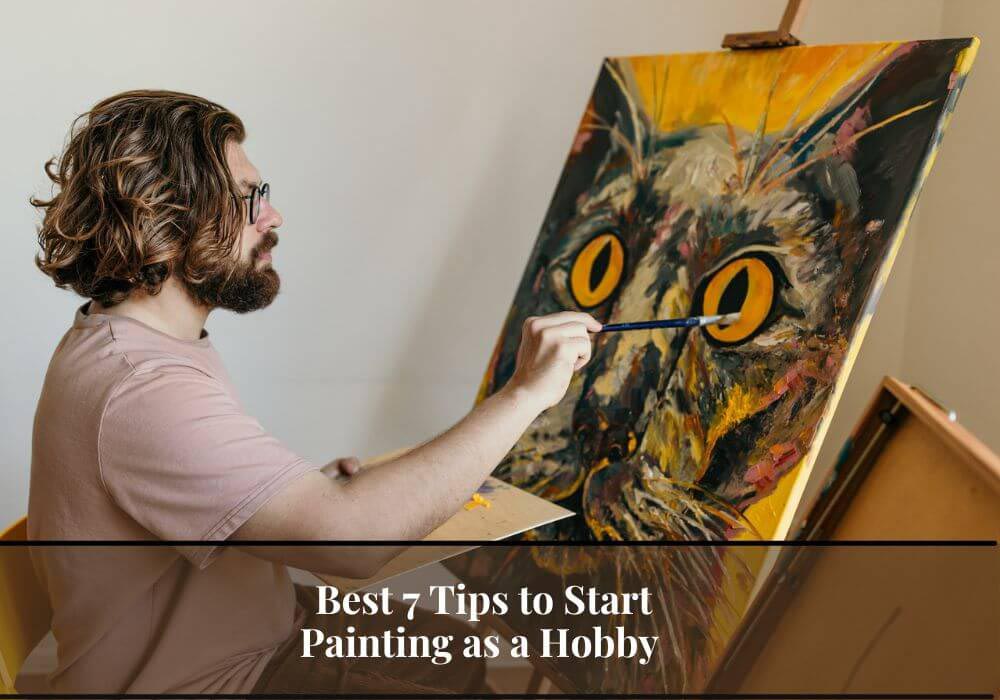
Are you looking for a new hobby? If so, painting may be the perfect choice for you! Painting can be a fun and relaxing way to spend your free time. In this post, I will share some of the most useful advice for beginning painting as a hobby. These suggestions will make it simple and enjoyable for novices to begin painting. So if you are looking for a new creative outlet, or just want to learn how to paint, then keep reading!
Benefits of painting & Challenges for beginners:
Before I go deep, I’d like to share the following advantages of pursuing painting as a hobby:
- Firstly, painting is a great form of self-expression. You can use paint to express your emotions, tell a story, or just capture a moment in time.
- In addition, painting can be calming and act as a form of therapy. It may help you de-stress at the end of tiring days.
- Thirdly, painting is a fun and rewarding hobby. It’s always satisfying to see your finished painting, and it can be a great conversation starter.
- You don’t need to go outside to start the hobby so it’s an ultimate pastime.
- And lastly, Not only can you find enjoyment from painting, but you can also make money by selling your paintings.
You can read the article “hobbies to do at home” to know more about various indoor hobbies.
Although painting has several benefits, there are also a few challenges you face when starting out. Let’s take a look at those as well.
- The first challenge is that painting takes time and practice to get good at it. Patience is essential in this situation. It can be frustrating at first if you are not immediately creating masterpieces.
- Another considerable factor is that painting can be expensive. You need to buy supplies such as paint, brushes, canvas, and other materials.
However, don’t let these challenges discourage you! Painting is still a great hobby to pursue. Painting can be expensive, but you don’t need the best supplies to get started. At your local craft store, you can purchase affordable supplies. And remember, it takes time and practice to get good at painting. Just keep painting and enjoy the process!
Now that you know some of the advantages & challenges of painting, let’s get into the nitty-gritty of starting out.
First Select a Medium (Acrylics, Oils or Watercolors):
The first thing you need to do is select a painting medium. The three most popular painting mediums are acrylics, oils, and watercolors. Each paint has its own set of characteristic.
- Acrylic paint is fast-drying, versatile, and durable. It’s a great choice for beginners because it is easy to work with.
- Oil paint is slow-drying, but it produces a rich and vibrant color. It can be difficult to work with, so it’s not the best choice for beginners.
- Watercolor paint is transparent and has a delicate appearance. It can be challenging to control, but it’s a great medium for painting nature scenes.
What are the materials you’ll need to get started painting?
Once you’ve selected a painting medium, it’s time to choose your supplies.
First, you need to decide what type of brushes you want to use. There are many different types of painting brushes available, but the most important thing is to find ones that feel comfortable for you to use. It’s also a good idea to get a variety of brush sizes so you can experiment with different painting techniques.
In addition to brushes, you will also need a palette. A palette is a flat surface where you mix your paint colors. You can buy disposable palettes at your local craft store, or reuse an old plate or tray.
Paint is the main ingredient in painting, so it’s important to choose the right type. As I mentioned earlier, there are three main types of paint: acrylic, oil, and watercolor.
- Acrylic paint is available in tubes or bottles. It comes in a wide range of colors, including both traditional and bright colors.
- Oil paint is also available in tubes or bottles. It has a thicker consistency than acrylic paint, so it’s important to mix it with a painting medium such as linseed oil.
- Watercolor paint comes in tubes, pans, or liquid form. The colors are usually more transparent than other types of paint.
However, to start painting you can start with any paint you have at home, such as house paint, poster paint, or even food coloring.
Finally, I would say, just start by purchasing a few basic supplies, such as canvas, paintbrushes, and acrylic paint. Once you have these items, you can experiment with different techniques and find the supplies that work best for you.
How to start as a beginner?
Now that you have all the supplies you need, it’s time to start painting!
Painting as a hobby can be really fun and rewarding. For starters, painting can be done anywhere. Painting does not require any expensive equipment or materials. You can also be painting at your own pace. There is no pressure to complete a painting in a certain amount of time. You can work on it for an hour or two, or even just a few minutes.
So, first try to draw:
Learning to the drawer is a process that requires time and effort. However, it’s important not to get discouraged if you don’t see progress immediately. Instead, remain patient and Persevere while enjoying the journey! Additionally, focus on your enjoyment rather than being too critical of your work in order to avoid losing sight of why you’re doing this activity. Here are some tips to make things go more smoothly on your journey to learn how to draw:
- It’s okay to doodle and not feel like every drawing has to be a masterpiece.
- Begin with simple subjects like a single item in your room, and not a complete still life right away.
- When sketching, apply light pressure to your pencil. It’s simpler to modify and erase delicate lines.
- Start with the basics. Learning perspective and proportions before focusing on minute details will help you create a more realistic final product.
If you’re just starting out, drawing from memory is often difficult and mistakes are common. To improve, use templates or shapes as guidelines for your next drawings. Even something as simple as tracing can help you develop the small muscle control needed for precise drawings.
And then, start to Paint:
If you’re itching to try your hand at painting, but feel more comfortable with a pencil and paper, know that it requires different techniques and materials than drawing does. If you want to venture into the world of painting, here are some tips:
- A good foundation in your artistic eye will lay the groundwork for developing both fine motor skills as well as giving rise to an original style that sets oneself apart from other artists – this includes being able to work with different mediums too!
- Get to know the basics of painting. Similar to drawing, shapes, sizes, and perspective is key for a good painting. You should also learn about color theory so you can create the desired effect (e.g., complimentary colors).
- Don’t start with difficult paints. You may begin with acrylic paints, for example, rather than oil paints, which are more difficult to handle and frequently need additional primers and solvents. A school paint box full of watercolors is a great place to start if you’re still quite green.
- Start slow and low-pressure. Give yourself time to get better rather than putting too much pressure on yourself to create a masterpiece from the start. It’s okay if your first paintings aren’t perfect–there’s always room for improvement! And even if you don’t love the final product, consider it a learning opportunity and helpful experience that will make future paintings easier.
- Sketch your painting with light pencil lines to begin. This lets you make adjustments before applying the paint. If you want to be more spontaneous, start with paint and let your creativity go wild.
Painting should be relaxing, so take your time and enjoy the process. Allow yourself to make mistakes, and don’t be afraid to experiment. And don’t be discouraged if your painting doesn’t look perfect. Remember, painting is a hobby and it’s supposed to be fun! So don’t get too worked up about it.
Follow other painters and artists to find new ideas:
Identify your ideal painters and observe their work to improve your painting job. It provides you with encouragement. One great way to do this is by following other painters and artists on social media. This will help you see what others are painting and how they approach their work. You can also find painting groups on social media where you can share your work and get feedback from other artists.
In addition, there are plenty of painting tutorial videos available online. These can be a great resources for learning new painting techniques or improving your skills. You can also find painting classes offered in your community, which can be a great way to meet other painters and get some hands-on experience.
Perfectionism is sometimes speed-breaker — so just get started!
The key to painting (or anything else in life, for that matter) is just to start. It doesn’t matter if your work isn’t perfect because the purpose of painting (or doing anything else) should be enjoyment. Let go of any perfectionist tendencies and simply allow yourself to relax, have fun, and see where your creativity takes you!
Painting as a hobby has never been easier. The more paint you put on the brush, the thicker it gets. It’s simply a matter of technique and practice to get good at it. As with anything new, there are some kinks that need to be ironed out before things can truly begin. In this post, I’ve attempted to focus on some proven methods for people who want to start painting as a hobby. I hope these suggestions have assisted you in getting started. Please leave any additional advice in the comments area! Thank you for reading and good luck with your painting!
YOU CAN ALSO READ :
*Best 16 Outdoor Hobbies to Try: Get the Most Out of Your Life.
*Best 14 Hobbies to Do at Home to Stay Active and Mentally Refreshed.
*Coin Collecting for Beginners: 15+ Useful Guidelines You Need to Know
